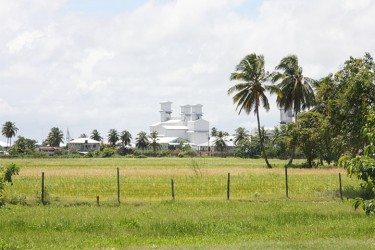The twenty or so farmers who had assembled in a storage bond at Land of Plenty belonging to rice miller Ramesh Ramotar had done so at the invitation of the miller. A representative of the Guyana Rice Producers Association. (GRPA) was also present at the meeting.
The whole idea of the meeting was to try to talk through what appeared to be an impending emergency in the rice sector on the Essequibo Coast. Ramotar wanted to make the point to the farmers that with this year’s second crop currently in the process of being reaped, his silos were still filled with around 900 tons of paddy from the previous crop. He wanted the farmers to know that he was out of storage capacity. Some of the farmers appeared anxious and turned to the man from the GRPA, Dharamkumar Seeraj. They wanted assurances that the Guyana Rice Development Board (GRDB) would be redoubling its efforts to sell more rice abroad so that the silos could be emptied to make way for the current crop. This is part of what lies at the heart of the present uneasiness in the rice community in Essequibo.
Afterwards, the farmers talked among themselves about just how filled the rice silos on the Essequibo were anyway. Some surmised that talk about packed silos was simply

part of a pattern of ‘gaff’ that was intended to help send the message about the need to accelerate the process of selling rice in overseas markets.
It was a mostly good-natured meeting. Ramotar told the meeting that he had paid the farmers from whom he had bought paddy in full. Indeed, this appeared to place him on good terms with the Land of Plenty farmers and farmers from nearby communities. The same, it seemed, cannot be said for the relationships between other millers and farmers.
The issue of late payments cannot be wished away. Some of the farmers at the meeting were saying that they would be prepared to accept a minimum of $3,000 per bag for their paddy – that was on the condition that they received their payments on time under the conditions stipulated in the Factories Act. For last year’s final crop they were paid prices ranging from $3,100 to $3,700 per bag of paddy but then they have to wait, sometimes for many months for payment.
After they had eventually exhausted the vexed issue of late payments (which has actually been the subject of protests on the Essequibo Coast) the meeting turned its attention to the high cost of production. It transpires that it costs around $70,000 to cultivate an acre of rice…if you own the land, that is. At a yield of between 35 and 40 bags of paddy you get a return of around $124,000. That means a profit of $54,000. If you lease the lands it costs $40,000 per acre. Take that amount away from the profit made by the land-owing rice farmers and it leaves a return of $14,000 on every acre. Some farmers, however, still lease lands. For them buying lands these days is out of the question. Rice lands on the Essequibo Coast fetch prices of around a million dollars an acre, when such lands become available, that is.
The costs associated with land preparation for sowing the rice crop include:
First cut (ploughing) – $4 500 per acre
· Second cut (ploughing) – $ 4 500 per acre,
· Back blading and levelling – $ 4,500
· Purchase of seed paddy – 1 ¼ bag per acre -$ 7 500
· Labour costs (sowing seed paddy– per acre – $ 2 000
· Fertilizer (1 bag per acre) – $ 7 500
· Urea (2 bags per acre) – $ 5 000
· Labour costs (application of fertilizer) per acre – $ 1 500
· Labour costs – spraying pests – $12, 000 per acre
· Harvesting of paddy – $ 300 per bag –
· Transporting (paddy to mill) – $ 100 per bag
Not only are rice cultivation costs climbing but rice farmers on the Essequibo say acquiring labour has become increasingly challenging while late payments have reduced their creditworthiness.
The myth of rice farming being a ‘bed of roses’ is gradually giving way to the realities of the industry. Diversification, mostly into cash crops and small herds of cattle have long been in evidence. These days the practice is more pronounced. One of the problems, the farmers say, is that their own children are turning away from the rice sector. Continuity could be a challenge.
Ramotar, himself a businessman with varied interests, is urging greater pragmatism on the part of the rice farmers. He says that while market growth justifies the expansion of the rice sector the challenges associated with selling rice mean that farmers need to be all the more mindful of reinvesting all of their profits in the sector. So often, however, the farmers seem, sometimes, to believe that they have no real option.




